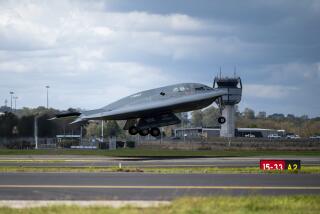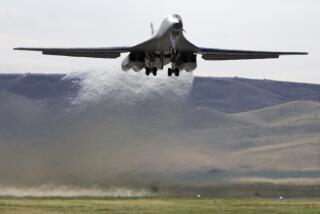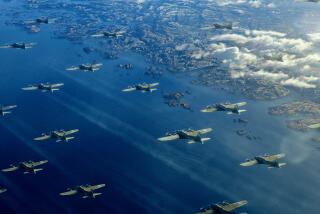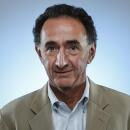Stealth Bomber Near Test; Can It Fly Financially?
- Share via
One day this month, test pilots Bruce J. Hinds of Northrop and Col. Richard S. Couch of the Air Force are expected to pull back on the throttle of a B-2 stealth bomber and accelerate down a runway in Palmdale for the controversial aircraft’s historic first flight.
If all goes well, the flying wing airplane, which lacks a conventional fuselage and is made largely of plastic composites, will climb to 10,000 feet, fly over Southern California for 2 1/2 hours and then land at Edwards Air Force Base about 35 miles east of Palmdale.
The first flight, which has been long delayed, will be among the most closely followed aeronautical excursions in recent history. Members of Congress, the Pentagon and the American public, which is footing the estimated $70-billion bill for 132 B-2s, are all waiting to see whether the eerie-looking, somber gray aircraft can actually defy the forces of gravity and--perhaps more important--the forces of politics.
B-2 critics in Congress are attacking the program’s budget and have succeeded in diverting about $800 million in proposed B-2 funds for other military projects closer to their hearts or home districts. Their opposition has put even more importance on the success of the flight test and on avoiding technical problems that would drive up the program’s cost.
The often-cynical B-2 debate in Washington has done little to dampen spirits at the Mojave Desert facility where a team led by Northrop is putting the final touches on the first B-2. The Air Force and Northrop have a work force of about 2,000 people, mostly at Edwards Air Force Base, just to conduct the B-2 flight tests. The first flight is targeted for mid-July, about 1 1/2 years behind the original schedule.
Celebrity Status
Hinds and Couch, whose identities had long been kept secret by the Air Force, have become something of celebrities at the B-2 facilities. “It’s quite an honor for them to fly this airplane,” said Air Force spokeswoman Capt. Tess Taft, after confirming a Times inquiry about their identity.
So confident is Northrop of the success of the B-2’s first flight that the company printed 25,000 commemorative post cards, featuring a picture of the bomber framed by red, white and blue borders. The post cards quickly sold out at an employee store and another 15,000 were printed, which also sold out. Although the identity of Hinds and Couch was supposed to be a secret, there was a virtual stampede by employees to have the two pilots autograph the post cards.
Hinds, 50, who will command the B-2 in the first test flight, has piloted 66 types of aircraft, including such diverse ones as the U-2 spy plane, the F-16 jet fighter and the massive C-5 cargo jet.
The Air Force has refused to allow any interviews with the test pilots or key B-2 program officials. Government information on the plane is coming either from high-ranking Air Force officers or Pentagon leaders who are attempting to combat the outpouring of negative comment from critics.
Need for B-2s Questioned
The B-2 is designed to fly 6,000 miles without refueling into enemy territory, eluding enemy radar with its unusual contours and plastic skin, and drop a payload of up to 25 tons of nuclear weapons on enemy targets, including mobile missiles that are difficult to attack with U.S. intercontinental missiles. Critics have questioned the need to spend $70 billion on a fleet of B-2s just to attack mobile missiles.
“What we have here is a plane in search of $70-billion worth of mission,” said longstanding B-2 critic Gordon Adams of the Defense Budget Project, a public interest group in Washington.
But Air Force officials sharply reject claims that the B-2 is too costly.
“There is no lower-cost way of covering those targets,” said Gen. Larry D. Welch, Air Force chief of staff, in an interview. He added that the B-2’s cost is explained by the technological advances necessary for its aeronautical design and production methods.
‘Won’t Fly Financially’
Congressional experts say, however, that at $530 million each, the B-2s are unaffordable. The figure includes future inflation, money already spent on development and much ground equipment. After years of total secrecy, the Air Force finally declassified the B-2 budget last week, disclosing that the program will require roughly $7 billion to $8 billion in annual funding during the mid-1990s, more than the United States has spent on any weapons program in history.
If the annual spending is cut and the program stretched out, then its total cost of $70 billion will go up sharply, leading to a cost spiral that is likely to make the program even less politically acceptable.
“The Department of Defense has produced a B-2 bomber program that won’t fly financially,” said House Armed Services Chairman Les Aspin (D-Wis.). “Members of Congress are balking at spending $4.1 billion this year for (Star Wars). It is not realistic to think we can spend twice as much per year on a plane.”
Staff members under Aspin said they expect even deeper cuts than the $800 million taken out by the committee once the issue reaches the House floor. Sen. John Glenn (D-Ohio), the former astronaut and test pilot, has called for a stop to even the current low-level production of the aircraft until it has been tested.
“The B-2 is a total departure from our usual new aircraft. There are new control concepts . . . and new aerodynamics, just to name a few. Going ahead with additional production before flight tests have even started just doesn’t make sense,” he said.
If the B-2 had come along a few years ago, amid the Ronald Reagan Administration’s defense buildup, the current debate might have been avoided. But technical problems and competition against Rockwell International’s B-1 bomber delayed production until the current Pentagon budget crisis.
Northrop was ordered in 1983 by the Air Force to redesign and strengthen the aircraft’s wing, a costly $1-billion effort. The stronger wing was necessitated because the Air Force wanted the option of flying the B-2 at near-ground level. The planes’ unusual shape and plastic materials are suppose to deflect radar waves, but low-level flight also would help it slip under enemy radars. Such low-level flight adds significantly to aerodynamic loads and fatigue.
Another setback was the death last year of Northrop Vice President John Paterno, who was general manager of the bomber program and said to be the “spiritual father” of the aircraft. Northrop quickly promoted Ed Smith, a former Rockwell International executive, to replace Paterno.
‘Grave Concerns’
At least some defense officials have been unhappy with Northrop’s performance. Recently retired Undersecretary of Defense for Acquisition Robert B. Costello said he attempted to kill the program because of “grave concerns” about Northrop’s quality. But Costello’s opinions have been disputed by current Pentagon leaders, who say “Northrop is putting a tremendous amount of attention on quality.”
Nonetheless, a series of technical problems earlier this year again forced a postponement of the first flight. In one incident, part of the pressurization system, called the environmental control system, burst and scattered debris inside the aircraft. That has since been fixed, according to Northrop President Kent Kresa.
Other technical problems have included what the Air Force describes as “minor difficulties” with the fuel system, flight control software and hydraulics, but details are unknown. In dealing with all of these, the Air Force is following a policy of avoiding rigid schedules and instead advancing the program only after specific milestones are achieved.
Air Force Secretary Donald B. Rice said in an interview last month that the B-2 “represents a revolutionary advance in technology and capability,” but he added cautiously: “If the plane has unexpected serious difficulties (in testing), that will require a complete reassessment. By their nature, research and development involve uncertainty.”
So far, the Air Force has spared little in avoiding that uncertainty.
The test pilots have spent many hundreds of hours training in a computerized B-2 simulator at Northrop’s Pico Rivera facility over the last five years. But when Hinds and Couch rumble down the runway, it will be no computer exercise. Despite massive investments in wind tunnel tests and computer simulations, the B-2 involves any number of aerodynamic unknowns.
The bomber is the first flying wing in nearly four decades, since Northrop founder Jack Northrop pioneered the concept in the late 1940s. Only since 1979 have aeronautical authorities validated Northrop’s belief that a flying wing is the most efficient means of carrying heavy payloads--in this case nuclear bombs.
In an extraordinary letter in 1979 to Jack Northrop, former National Aeronautics and Space Administration chief Robert A. Frosch wrote that a recent study had led the agency to “rediscover the flying wing” and that examination of Jack Northrop’s three-decade-old wind tunnel data “confirmed your much earlier conviction.”
Since nobody has flown a flying wing for more than three decades, Hinds and Couch cannot be certain exactly how the B-2 will handle in the air. One of the last pilots to fly a flying wing was Max Stanley, Northrop’s chief test pilot in the late 1940s, now retired but still a valuable source of information.
Stanley said he believes that Hinds and Couch will discover that the B-2 will handle like any conventional aircraft.
“In my opinion, it was a very good flying airplane,” Stanley said. “I have a great deal of confidence in the B-2.”
Even if the B-2 confirms what Jack Northrop believed in the 1940s, the company and the Air Force will have a difficult time persuading Congress to put the aircraft into production. Defense Secretary Dick Cheney has already delayed full-scale production by one year because of a lack of funds, and senior defense leaders are reportedly considering a second year of postponed production.
But in the Mojave Desert, flight crews are anxious to prove the B-2 is worthy. When the flying wing finally makes its maiden flight to Edwards Air Force Base, they believe it will be a fitting tribute to Capt. Glenn W. Edwards, the pilot who was killed in June, 1948, when his jet-powered Northrop YB-49 flying wing went out of control and crashed. Edwards Air Force Base was named in his honor.
Staff writer John Broder contributed to this story from Washington.
More to Read
Inside the business of entertainment
The Wide Shot brings you news, analysis and insights on everything from streaming wars to production — and what it all means for the future.
You may occasionally receive promotional content from the Los Angeles Times.












